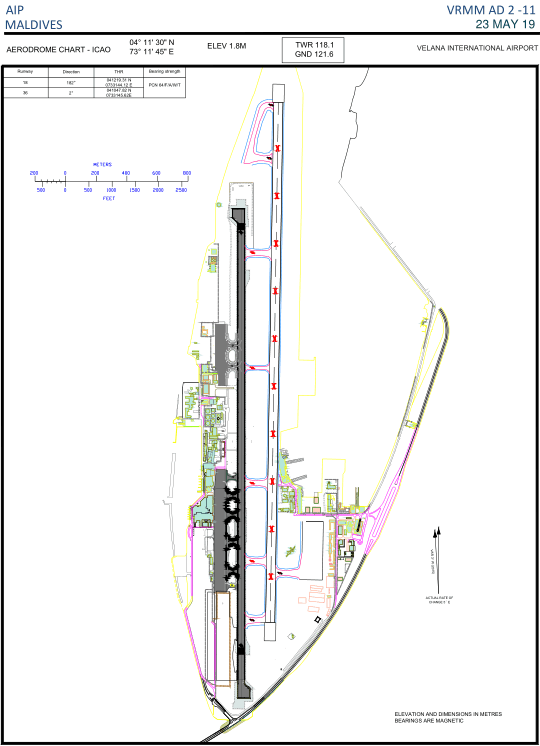Parking Procedures
No aircraft stands are available. All aircraft will be guided to the respective parking spots by marshallers. In the absence of marshallers the controller will issue parking instructions on the radio.
VRMF - Notams
VRMM Velana Intl. Landing Charts - Old
VRMM Velana Intl. Approach Charts - Old
VRMM Velana Intl. Departure Charts - Old
No aircraft stands are available. All aircraft will be guided to the respective parking spots by marshallers. In the absence of marshallers the controller will issue parking instructions on the radio.
All aircraft entering and exiting the main apron will be instructed by the controller about the taxiway to be followed. If another taxiway, other than the one allocated is desired, specific ATC clearance is to be obtained.
Due to the close proximity of the terminal and other associated building with the manoeuvring area, all aircraft are to avoid making tight turns and using excessive power for taxing to and from the main apron.
Medium aircraft with MAX landing weight of 49t or above are prohibited to make 180 degree turns on RWY 18/36,180 degree turns allowed only on runway turn pads during 0600-1100UTC.
Heavy aircraft must make 180 degree turns on RWY 18/36 turn pads only.
On push-back, aircraft may start engine on idle power.
As far as possible, cockpit and cabin checks should be completed prior to lineup.
Pilots should ensure that they are able to commence the take-off run immediately after take-off clearance is issued. Pilots not able to comply with this requirement must notify ATC prior to the commencement of taxiing.
Upon lining up on the runway, when a take-off clearance is issued, aircraft shall commence take-off without delay.
For category A, B and C aircraft, ATC will propose taxiway intersection take-offs with the available TORA provided. The decision to accept or refuse such intersection take-off rests with the pilot in command.
Aircraft taxiing on the runway should maintain a preferred speed of 25 KT or more, except while turning.
All departures from RWY 36, shall continue on RWY heading until 3NM from MLE VOR/DME.
Due to noise sensitive area around the final approach of RWY 36, jet or heavy aircraft making visual approach RWY 36 shall extend downwind leg and join final beyond 7NM and shall not descend below the circuit altitude until established on the final.

The inbound, transit and outbound routes shown on the charts may be varied at the discretion of ATC. If necessary, in case of congestion, inbound aircraft may be instructed to hold at one of the designated airways reporting points.
Before conducting any VFR / seaplane flight, the following details must be submitted to ATC with the flight plan.
1. Type of aircraft with callsign
2. Destination or area of operation (Ex: 25 dme, Radial 040 MLE VOR)
3. Desired altitude
4. Estimated duration of flight
5. Purpose of flight
5. Total endurance
a] All flights (eg: photography, training, aerial survey flights etc.) may be flown at an altitude or flight level at or below FL195, with ATC approval.
b] All flights inside or outside of controlled airspace are required to maintain continuous listening watch on the controller's frequency.
c] Standard VFR / seaplane departure (Refer Fig: 1) and arrival (Refer Fig: 2) routes are to be followed, unless instructed by ATC.
d] VFR flights in level cruising flight within TMA below 6000 feet shall be conducted at an altitude specified below:
Magnetic Heading 000°- 179° > 1500ft, 3500ft, 5500ft
Magnetic Heading 180°- 359° > 500ft, 2500ft. 4500ft
A large seaplane base is located at the eastern side waterfront of VRMM. (Refer below Fig. 1) The adjoining lagoon is frequently used by seaplanes for takeoff and landing. These are supplementary procedures applicable to seaplanes landing and taking off at VRMM Airport and other designated landing spots inside the TMA. Pilot in command shall adhere to all Visual Flight Rules and procedures given below.
a] Three deep channels in the lagoon represent takeoff/ landing areas.(Refer below diagrams.)
i. North-Left/South-Right (NL/SR)
ii. North-Right/South-Left (NR/SL)
iii. East/West (E/W)
b] Access to the seaplane maneuvering area is subject to ATC clearance.
Note: seaplane maneouvering area comprises take-off/landing areas and adjoining channels designated for seaplane taxiing and holding.
a] Seaplane takeoff and landing direction should as far as practicable coincide with the VRMM runway in-use.
b] Water runway North-Left shall NOT be approved for arrivals.
c] Water runway South-Right shall NOT be approved for departures.
a] Prior to taxi pilot shall contact Male controller and submit the flight plan information, and obtain the ATC clearance.
b] After takeoff aircraft to remain well clear of the Approach / Takeoff path of VRMM runway 18/36.
Flyantics
Student Pilot: "Approach, Cessna 123, request two practice ILS approaches, followed by the published missed to the MLE VOR to hold, then a VOR approach, followed by two NDB approaches, and finally an ASR approach."
VRMM Approach: "Cessna 123 squawk 4753, and would you like fries with that, sir?
***
A heavy 747 come in for a very hot landing and thus had an exceedingly long roll out after touching down.
Colombo Tower noted: "Cargo 101, make a hard right turn at the end of the runway 22, if you are able. If you are not able, take the Katunayaka exit off Highway to Negambo, make a U turn at the lights and return to the airport."